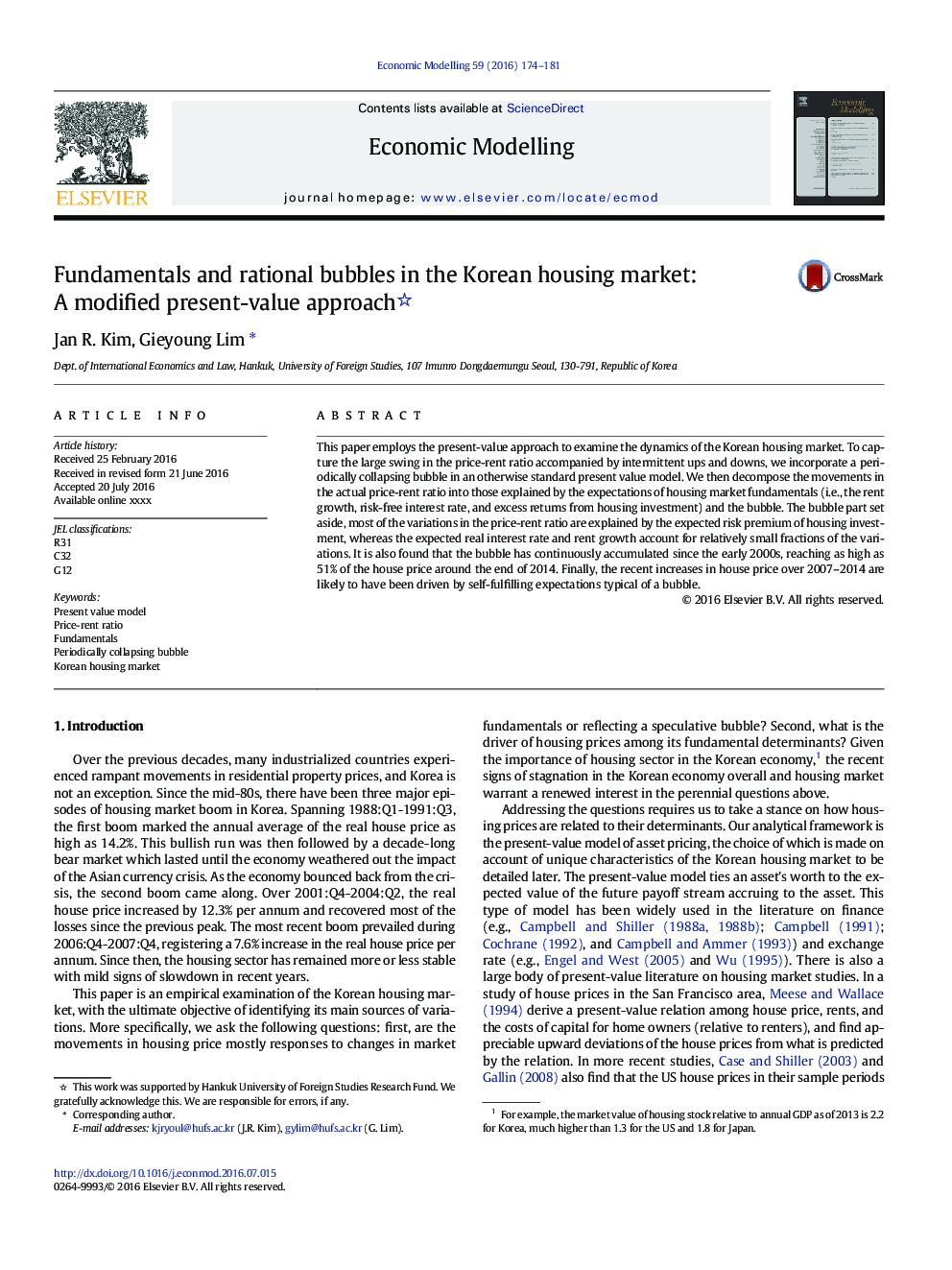| کد مقاله | کد نشریه | سال انتشار | مقاله انگلیسی | نسخه تمام متن |
|---|---|---|---|---|
| 5053285 | 1476510 | 2016 | 8 صفحه PDF | دانلود رایگان |
عنوان انگلیسی مقاله ISI
Fundamentals and rational bubbles in the Korean housing market: A modified present-value approach
ترجمه فارسی عنوان
اصول و حباب های منطقی در بازار مسکن کره: رویکرد ارزش فعلی اصلاح شده
دانلود مقاله + سفارش ترجمه
دانلود مقاله ISI انگلیسی
رایگان برای ایرانیان
ترجمه چکیده
این مقاله از رویکرد ارزش فعلی برای بررسی پویایی بازار مسکن در کره استفاده می کند. برای رسیدن به نوسان بزرگ در قیمت اجاره با همراه شدن با وقفه های متناوب، ما یک حباب در حال فروپاشی دوره ای را در یک مدل ارزش فعلی استاندارد در نظر می گیریم. سپس جنبش ها را در نسبت قیمت اجاره واقعی به مواردی که با انتظارات مبانی بازار مسکن (یعنی رشد اجاره، نرخ بهره بدون ریسک و بازده بیش از سرمایه گذاری مسکن) و حباب توضیح داده شده، تجزیه می کنیم. بخش حباب کنار گذاشته شده است، بیشتر تغییرات در نسبت قیمت اجاره به واسطه ریسک احتمالی سرمایه گذاری مسکن توضیح داده می شود، در حالی که نرخ بهره واقعی انتظار می رود و رشد اجاره منجر به تقسیم نسبتا کوچکی از تغییرات می شود. همچنین مشخص شده است که حباب از اوایل سال 2000 تا کنون به طور مداوم جمع شده است و تا پایان سال 2014 تا قیمت 51 درصد از قیمت خانه در حال افزایش است. در نهایت، افزایش اخیر قیمت خانه در سال های 2007-2014 احتمالا به دلیل انتظارات خودآموزی معمولی از یک حباب.
موضوعات مرتبط
علوم انسانی و اجتماعی
اقتصاد، اقتصادسنجی و امور مالی
اقتصاد و اقتصادسنجی
چکیده انگلیسی
This paper employs the present-value approach to examine the dynamics of the Korean housing market. To capture the large swing in the price-rent ratio accompanied by intermittent ups and downs, we incorporate a periodically collapsing bubble in an otherwise standard present value model. We then decompose the movements in the actual price-rent ratio into those explained by the expectations of housing market fundamentals (i.e., the rent growth, risk-free interest rate, and excess returns from housing investment) and the bubble. The bubble part set aside, most of the variations in the price-rent ratio are explained by the expected risk premium of housing investment, whereas the expected real interest rate and rent growth account for relatively small fractions of the variations. It is also found that the bubble has continuously accumulated since the early 2000s, reaching as high as 51% of the house price around the end of 2014. Finally, the recent increases in house price over 2007-2014 are likely to have been driven by self-fulfilling expectations typical of a bubble.
ناشر
Database: Elsevier - ScienceDirect (ساینس دایرکت)
Journal: Economic Modelling - Volume 59, December 2016, Pages 174-181
Journal: Economic Modelling - Volume 59, December 2016, Pages 174-181
نویسندگان
Jan R. Kim, Gieyoung Lim,
